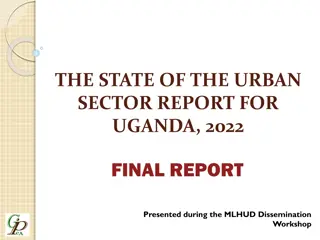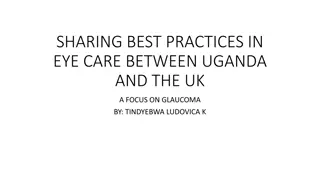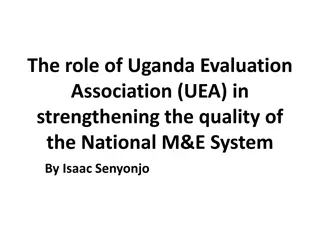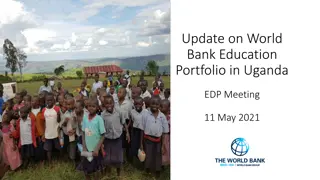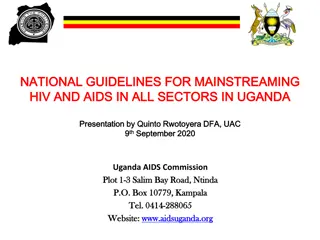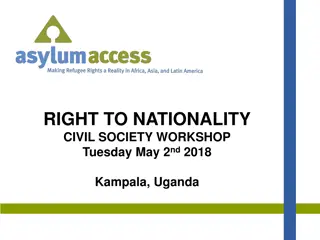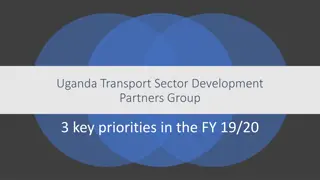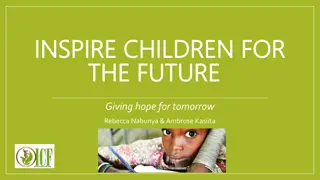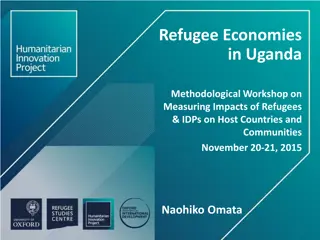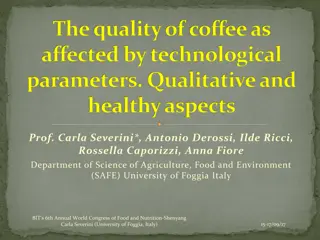Tackling Child Labor in Uganda's Coffee Sector: A Project Approach
The "Child Education Project Uganda" led by Rashida Nakabuga aims to address the root causes of child labor in Uganda, particularly in the coffee sector. With a focus on poverty, gender inequality, and inadequate education, the project adopts a risk-based due diligence approach at the farm level to combat child labor and forced labor. Collaboration with stakeholders and targeted interventions seek to mitigate risks and improve enforcement of laws. By targeting key root causes such as poverty and cultural norms, the project aims to create sustainable change and ensure access to education for children in Uganda.
Download Presentation

Please find below an Image/Link to download the presentation.
The content on the website is provided AS IS for your information and personal use only. It may not be sold, licensed, or shared on other websites without obtaining consent from the author. Download presentation by click this link. If you encounter any issues during the download, it is possible that the publisher has removed the file from their server.
E N D
Presentation Transcript
Child Education Project Uganda By Rashida Nakabuga AFCA February 2023
Contents RA introduction/child labour approach Why the project Intervention models Outcomes/Impact Strategic focus/way forward 2
Child Labor how does RA tackle this?
Assess and Address System Risk based due diligence approach at farm level Child Labor Forced Labor Focus on risk assessment and mitigation; capacity building for farms and auditors Assess and Address Issues Clear guidance and tools to support implementation and continuous improvement Workplace Violence & Harassment Discrimination
Tackling the root causes of child labor The best way to eliminate child labor is to tackle its root causes, which can include lack of access to education, weak enforcement of labor laws, gender inequality, poverty, and insufficient social protection for the poor. Rainforest Alliance works in partnership with key stakeholders, including civil society, govern- ments, and companies, to tackle this urgent issue.
Child labour in Uganda and the coffee sector Uganda population is 37.7 million, of which 17.3 million are children below 14 years of age (46%). 6.2 million children aged 5-17 years are involved in child labour in Uganda (UBOS 2022) Prior to this project, there was scanty data on child labour prevalence specifically in the coffee areas of Uganda Hivos/Rainforest Alliance funded project in West Nile found that ~40% of the households involved in the study keep children out of school to work. Despite having an adequate national legislative and policy framework, enforcement of laws and policies is weak. For example, law enforcement has insufficient funding, training and resources High prevalence of child labour both Masaka and Rwenzori averaging 37% in 2020 Relatively High poverty levels in (Rwenzori) of 48.4% compared to a national average of 31.1% 7
Key root causes in Rwenzori & Masaka 1. Poverty High poverty levels 2. Cultural Norms and Gender Inequality 3. Quality education 4. Policies and law enforcement Low awareness among communitiess 8
RVO child education project in Uganda Objective; Sustainable eradication and prevention of child labour at factory/community/region levels Partners: Kyagalanyi Coffee Ltd - Ugandan based coffee buyer/exporter and RA certificate holder; JDE Coffee roaster and global coffee buyer and CEFORD Local NGO Other partners; District local government, Hulleries, Police; cultural leaders and CSOs Duration = 3 years November 2020 October 2023 Areas (Rwenzori and Masaka) Target: children 6-17 years of age Approach=CLFZ-Area based-(A&A) 9
Operating models Masaka - context Higher prevalence of child labour among children 14 years and older. Relatively bigger farms and more estates. Region ravaged by HIV in the past decades Approach Sensitize employers on responsible employment of youths Skilling youths in income enhancing skills GAP at farm level to enhance farm income Attachment of youth to coffee farms (internships) 11
Continuation Rwenzori - Context Higher prevalence of child labour among children 13 years and below. Small farms average of half a hectare Mountainous terrain High poverty levels and low literacy levels Approach - Area based approach; Build community structures to map, identify, and remediate cases of child labour while sensitizing Build structures at schools to create a conducive and supportive environment. VSLAs to support saving and help with income at household level GAP at farm level to enhance farm income 12
Outcomes/Impact Masaka area Strengthened working relationship and strengthened Collaboration with government 2788 House holds have been mapped, 893 with child labour received support for remediation Over 30 coffee huller owners are improving working conditions and committed to shun child labour practices 204 youths are attaining income enhancing skills from local artisans 45 youths are attached to coffee farms for internships 4968 farmers were trained in GAP 13
Rwenzori Established and or Confirmed working relationship and strengthened Collaboration with government and schools Of the 3,302 HH mapped 1,372 were found with child labour and remediation support provided Child labour response structures established and trained in 15 schools (children s committees, PTAs, focal teachers, drama and reproductive health clubs) 1,297 girls retained in school due to provisions and skills in making re-useable sanitary rowels 30 child labour committees actively monitoring and remediating child labour cases in 3 sub counties 44 VSLAs established supporting 550 HH to save and access credit Over 2000 farmers trained in GAP to improve productivity of coffee on the farms 14
Rwenzori Child labour incidences have been reduced from 37% in 2020 to 27% in 2022 and children at risk have reduced from 40% in 2020 to 3.6% in 2022 Community leadership structures at subcounty level have adopted measures to periodically meet and discuss child labour issues in the communities while finding solutions to root causes of child labour Supply chain actors involved in the project has developed know how in designing and implementing community child labour response programs Girl child retention in schools has improved by 30% (school is fun and they gained skills in making reusable sanitary pads, . 15
Strategic focus: old and new projects Creating opportunities for cross learning among the project stakeholders Disseminating the model and lessons among other stakeholders and CHs Intentionally creating collaborations to sustain the efforts beyond the project life Integrate the community structures and beneficiaries in existing government programs and initiatives. Employ the use of the media in socializing the interventions and the successes to create awareness and increase adoption/scale out 16




